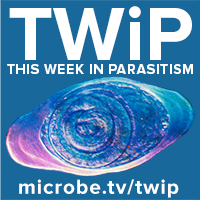The TWiP team solves the case of the Woman From Hawaii With Allodynia and abdominal pain, bilateral hip and leg pain, dizziness, and diffuse hyperesthesia.
Hosts: Vincent Racaniello, Dickson Despommier, Daniel Griffin, and Christina Naula
Click arrow to play
Download TWiP #209 (41 MB .mp3, 69 minutes)
Subscribe (free): Apple Podcasts, Google Podcasts, RSS, email
Links for this episode
- Use coupon code MicrobeTV when purchasing a spike t-shirt from Vaccinated.us
- Accidental host (TWiP 207)
- Hero: Dan Colley
- Letters read on TWiP 209
Become a patron of TWiP
Case Study for TWiP 209
Man in his early 70s with PMH sig for HTN, DM-II, HLD, BPH is admitted to the hospital after coming from Guatemala to visit his son. He feels faint with standing and is noted to have a HR in the 40s and does not feel well when he stands. He is also noted to have diarrhea, but this has been going for an unclear period of time. On EKG he is noted to have a RBBB.
PMH HTN, DM-II, HLD, BPH PSH neg
Allergies NKADR
Social -no toxic habits reported, reports living in Guatemala City but grew up in the rural areas. Enjoys fruit juice
FH-noncontrib
Exam: slow heart rate, orthostatic
A number of blood and stool tests are collected and he is referred to a tertiary care center for implantation of a cardiac pacemaker. At the tertiary care center the patient is seen by an Infectious Disease Specialist and a number of tests are ordered by the Infectious Disease Consultant but they are canceled by Cardiologist who writes in their note “no concern for an infectious process”. Now one of the tests collected at the first hospital returns with an interesting result that is later confirmed by a second test.
Send your case diagnosis, questions and comments to [email protected]
Music by Ronald Jenkees


My question is in an acute vs chronic condition with neuroangiostrongyliasis or other differentials would the eosinophils still be high in a chronic condition? My understanding is Rat Lungworm will die in the body, not complete it’s lifecycle in a human host. In this case the neurological challenges would still exist and not be treatable after the acute stage. Would a diagnosis with the two types of tests still be positive years later, when the eosinophils are not present.
Case Study for TWiP 209
Hello from rainy Trinidad and Tobago
I have quite enjoyed episodes of TWiP
after being introduced to it by a colleague this summer .
I am not sure if I am too late or not but I would like to submit my thoughts on this case of a Man in his early 70s with PMH significant for HTN, DM-II, HLD, BPH admitted to the hospital after coming from Guatemala to visit his son.
Given his age and history of being from rural Guatemala I would want to screen this patient for Chagas’ disease .
Though it possible that he could be Bradycardic from ischemic disease, his history offers other clues that he more than likely has complications of untreated Chagas’ disease which he would have acquired earlier.
Diagnosis using thick and thin smear would give evidence of acute Chagas .
In Chronic infection an antibody test becomes more useful.
Definitive Treatment in this case would be to pace the patient . One could also look for evidence of mega colon which could account for his gi issues .
Other treatment is normally nifurtimox or benznidazole. These will help with active infection but will not reverse the complications of disease . I wonder about screening his wife and his son if they lived in the similar environment .
Looking forward to the discussion of this case .
Ayanna